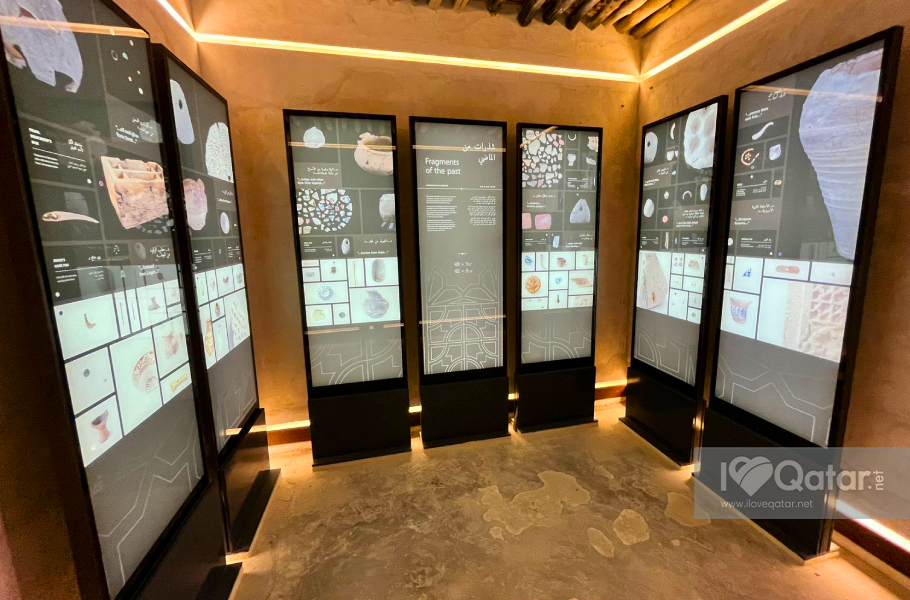
Do you want to immerse yourself in Qatar's history? Step back in time and discover the way of life at Al Zubarah fort, which has since been transformed into a museum.
The iconic Al Zubarah fort can be found at the forefront of a once-bustling pearl fishing and trading city.
The ILoveQatar.net (ILQ) team has put together a quick guide on what to check out at this magnificent site!

The Al Zubarah fort and the archaeological site were named a UNESCO World Heritage Site in 2013 for being an important site in preserving the rich history of early Qatari culture and way of life.
An inscription on the installation located on the left side of the fort indicates:
“The inscription confirms Al Zubarah’s outstanding universal value as an urban trading and pearl-diving town, a tradition that sustained major coastal settlements of the region from the early Islamic time to the early modern period.”

The fort features beautiful traditional Arabian architecture with one-meter-thick walls that protected its inhabitants from invaders and kept them cool during hot summers.
The wooden windows were secured with metal bars, and the wooden doors were secured with traditional sliding bolt locks.
There are also visible holes dotted around the walls that provided ventilation. If you examine them closely, you can feel a cool breeze, no matter how hot it is during the day!

The fort is a square structure with a wide-open courtyard. This is where the soldiers would assemble.
Stepping into this area gives you a 360-view of the stunning site. Each corner of the fort has a tower, three circulars, and one rectangular structure. Each side and tower houses small exhibits to explore.

To the right of the entrance, you’ll be able to spot a wall decorated with black and white photos of the abandoned Zubarah village. Each frame showcases the ruins and structures of the once lively town.
There are also wooden benches where guests can relax and enjoy the gallery.

The Al Zubarah fort well runs up to 10 meters deep and used to provide fresh drinking water all year round. It was dug by hand through hard dammam limestone to access the clean water.
In the past, a wooden bucket was lowered into the well to collect drinking water. However, it is completely dry today and has been safely barricaded.

The sea was very important to the people of Al Zubarah as it provided sustenance, wealth, and trade.
The main source of food came from fish, pearl divers explored the deep waters for wealth, and traders used the seaside of Al Zubarah to bring foreign trade.

The Hidden Beauty exhibit showcases the flora and fauna that flourished in Al Zubarah.
At the end of the area, you’ll find an interactive table where each circular plate contains information about the plant or animal wildlife, and upon lifting, the plate would reveal an image of it.

This exhibit introduces the Qatar Islamic Archaeology and Heritage (QIAH) project, a Qatar Museums (QM) initiative in cooperation with the University of Copenhagen, which involved a team of experts that excavated the heritage site and other areas in Qatar to study and uncover its diverse history.

Continuing the tour through Qatar’s history will take you to the Fragments of the Past exhibit, where you will find information on the artefacts uncovered of what early Qataris used on a daily basis.
These include weights used by pearl divers, ceramics, coffee cups, kitchenware, and more from the 18th to the 19th century.

Finally, end your tour with a compilation of Zubarah’s beginning and its international significance in preserving the history of early civilization.

Visit the site just beyond the Al Zubarah Fort and discover the well-preserved 18th and 19th-century merchant town that once thrived. Remains of the town date as far back as the 1760s. Close to the site is the Qal’at Murair, which once protected the city’s inland wells.

After visiting Al Zubarah Fort, hop on the free shuttle to the archaeological site. The boardwalk and new signage boards make the town accessible to everyone, including people with mobility issues.
Wander again through the streets of Al Zubarah, and discover one of the best-preserved examples of an 18 & 19th-century trading and pearl fishing town in the Gulf!

If you feel like you haven’t gotten enough of history and want to explore a bit more, you can head over to the abandoned Al Jumail Fishing Village, just 15 mins away from the Al Zubarah fort.
It’s also commonly known as Qatar's "ghost town".

Explore the ruins and let your imagination run wild as you reimagine what the village used to look like and how the people lived. Discover the courtyard and go through the abandoned homes.

Al Jumail was once a busy fishing village and is surrounded by water. Walk through the alleys of the abandoned village and eventually, you will find paths that will directly bring you to the sea.
Please note:
Are you planning to visit the Al Zubarah fort? What are you most excited to see? Let us know in the comments! Do share this article - it keeps us going!
Follow us on our social media channels:
![]() @ILQlive
@ILQlive
![]() @ILQlive
@ILQlive
![]() @ILoveQtr
@ILoveQtr
![]() ILoveQatar
ILoveQatar

You have successfully registered your account!
Please confirm your e-mail address by clicking on the URL sent to you.The e-mail usually arrives in 5-10 minutes.
How ajeeb was that!? Thanks for contributing to our community! Your post will appear after we take a quick look!